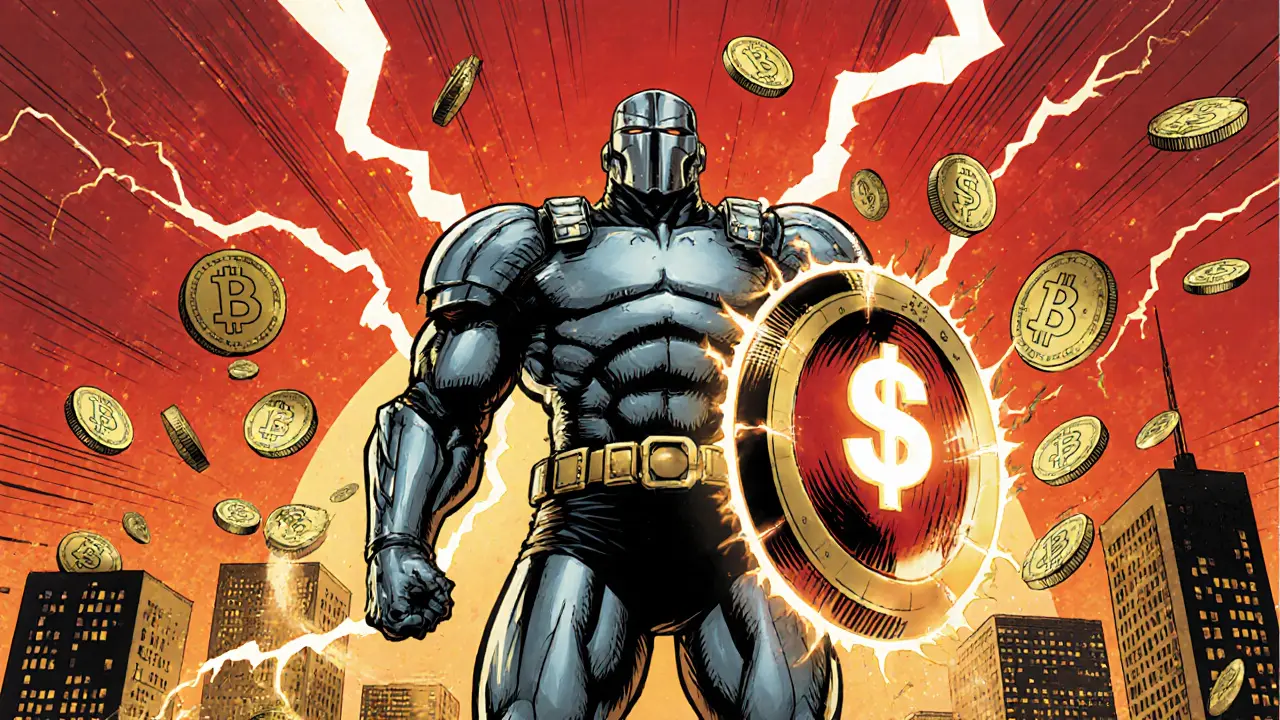Crypto Volatility Calculator
How Volatility Affects Your Investment
Calculate potential value changes based on historical cryptocurrency volatility (e.g., Bitcoin's 50-60% annual swings)
Can cryptocurrency really take over the dollar, euro, or yen? It sounds like something out of a sci-fi movie - digital money replacing the money in your wallet, controlled by code instead of central banks. But here’s the truth: cryptocurrency won’t replace fiat currency anytime soon. Not because it’s weak, but because fiat money isn’t broken - it’s just different. And in finance, stability beats innovation every time.
Why Fiat Currency Still Rules
Fiat money isn’t backed by gold or silver. It’s backed by trust - trust in governments, central banks, and the legal system. When you get paid in dollars, you know that dollar will still buy roughly the same amount of bread next week. That predictability matters. People don’t just want money - they want reliable money. Central banks control inflation by adjusting interest rates and printing money when needed. If the economy slows down, they lower rates to encourage spending. If prices rise too fast, they tighten the money supply. This kind of control keeps the system running. Cryptocurrencies like Bitcoin have no such mechanism. Bitcoin’s supply is capped at 21 million coins. That sounds smart - until you realize it means prices can swing wildly. A coffee that costs 0.001 BTC today might cost 0.002 BTC next month. No one wants to price their products in something that could halve or double in value overnight. Plus, fiat currency is everywhere. ATMs, debit cards, online banking, payroll systems - they’re all built for dollars, euros, yen. Switching to crypto would mean rebuilding the entire global financial infrastructure from scratch. No country is ready to do that.Where Cryptocurrency Actually Shines
That doesn’t mean crypto is useless. It’s better than fiat in some very specific areas. Cross-border payments are the clearest win. Sending money from Nigeria to Kenya through traditional banks can take days and cost 10% or more in fees. With crypto, you send it in minutes for less than a dollar. That’s why remittance companies and migrant workers are already using it. Crypto also offers privacy. Transactions don’t show your name, address, or ID number - just a string of letters and numbers. That’s great if you’re in a country with unstable banks or oppressive regimes. It’s also a problem if you’re trying to stop money laundering. Regulators hate that part. And then there’s the technology. Blockchain lets you build smart contracts - self-executing agreements that trigger when conditions are met. Imagine renting an apartment and your key unlocks automatically when your payment clears. No landlord, no paperwork. That’s real innovation.The Volatility Problem
Here’s the biggest roadblock: price swings. In 2021, Bitcoin hit nearly $69,000. By late 2022, it dropped below $16,000. In 2024, it climbed back to $70,000. That kind of rollercoaster is fine if you’re buying it as an investment. It’s disastrous if you’re trying to pay your rent with it. People don’t spend what they think will be worth more tomorrow. That’s why crypto holders tend to HODL - hold on for dear life. If no one spends it, it can’t function as money. Money needs to circulate. Fiat currency circulates because people trust it won’t vanish.
Regulation Isn’t Optional - It’s Essential
Governments don’t just control money - they protect you with it. If your bank account gets hacked, you get your money back. If a credit card is stolen, you’re not liable. If a payment fails, you can dispute it. Crypto? No such safety net. If you send funds to the wrong wallet, or lose your private key, it’s gone forever. No customer service. No refund. No legal recourse. That’s why countries are moving toward regulation. The U.S., EU, Japan, and others now require exchanges to collect user identities (KYC), report suspicious activity, and hold reserves. That’s not the wild west anymore - it’s becoming more like a bank. But here’s the catch: regulation means control. And control means centralization. The whole point of crypto was to remove middlemen. Once governments start regulating it like traditional finance, it starts looking a lot like… fiat.CBDCs: The Middle Ground
Instead of replacing fiat, crypto is pushing central banks to evolve it. Over 130 countries are now exploring central bank digital currencies (CBDCs). China’s digital yuan is already in use by millions. The European Central Bank is testing a digital euro. The Federal Reserve is researching a digital dollar. These aren’t Bitcoin. They’re digital versions of your national currency - issued by the central bank, backed by the government, and traceable. They offer fast payments, lower costs, and programmable features (like automatic stimulus payments), but without the volatility or anonymity risks of crypto. CBDCs are the real future - not crypto replacing fiat, but fiat becoming digital.


Pranjali Dattatraya Upadhye
November 8, 2025 AT 13:33Okay, but have you ever tried sending money to your cousin in Delhi from New York? Traditional banks? Absolute nightmare. Crypto? I sent $500 in 8 minutes for $1.20. No forms. No waiting. No ‘we need your third cousin’s birth certificate.’ That’s not ‘speculative’-that’s liberation. 🌍💸
Kyung-Ran Koh
November 8, 2025 AT 14:51I love this breakdown! 🙌 You're so right about CBDCs being the quiet revolution. I work in fintech, and every bank I talk to is quietly building their own digital ledger systems-no Bitcoin, no chaos, just faster, safer, government-backed digital cash. It’s like upgrading from dial-up to fiber without throwing out your router. 😊
Missy Simpson
November 9, 2025 AT 00:56YES!! I just paid for my coffee with USDC last week and the barista didn’t even blink. 😍 It’s not about replacing the dollar-it’s about making it *better*. Like adding airbags to a horse carriage. 🐴➡️🚗
Tara R
November 9, 2025 AT 04:40How quaint. You assume people care about stability. Inflation has eroded 40% of my savings since 2020. The system is broken. Crypto isn’t the problem. The Fed is. And you’re just defending the status quo like a corporate parrot.
Matthew Gonzalez
November 11, 2025 AT 01:44Money is a shared hallucination. Fiat works because we all agree to pretend paper has value. Crypto works because we agree to pretend code has value. The only real difference is who gets to control the illusion. The real question isn’t ‘which is better?’-it’s ‘who do you trust more: a bureaucrat or a mathematical algorithm?’
Michelle Stockman
November 12, 2025 AT 18:49So you’re telling me the solution to volatility is… more government? Brilliant. Let’s just put a bow on it and call it ‘Fiat 2.0.’ 🎀
Brian Webb
November 13, 2025 AT 19:09My dad still uses cash. My sister uses Apple Pay. I use crypto for international gigs. We all coexist. The idea that one system has to ‘win’ feels so 2012. It’s not a war-it’s a toolkit.
Leo Lanham
November 14, 2025 AT 09:51Bitcoin is dead. CBDCs are the future. Wake up. You’re all just crypto bros clinging to a dead dream. 🤡
Whitney Fleras
November 14, 2025 AT 11:11Love how you framed this. It’s not about replacing-it’s about evolving. Like how email didn’t kill letters, it just made them optional. Crypto’s doing the same thing to cash.
Colin Byrne
November 16, 2025 AT 08:14While your analysis is technically sound, you fail to account for the systemic fragility of centralized monetary control. The 2008 crisis, the 2020 money printing, the inflationary spiral-these are not anomalies. They are features. Cryptocurrency’s value lies not in its utility as currency, but as a decentralized audit trail against the inherent corruption of sovereign monetary policy. You call it volatility. I call it truth serum.
Benjamin Jackson
November 16, 2025 AT 15:31Man, I used to think crypto was just for tech nerds. Then my grandma started using a wallet app to get her pension from Canada to India. No fees. No delays. She doesn’t even know what blockchain is. She just knows her money shows up. That’s the real win.
Liam Workman
November 16, 2025 AT 16:24The beauty of this moment is that we’re witnessing the birth of a new financial language. Fiat is English-widely spoken, deeply entrenched. Crypto is Esperanto-still learning, but with the potential to connect the disconnected. Neither replaces the other. They just let more people speak. 🌐✨
Alexis Rivera
November 17, 2025 AT 16:54What’s fascinating is how crypto’s greatest strength-decentralization-is also its greatest weakness in the eyes of the public. People don’t want freedom from banks. They want banks that work better. That’s why CBDCs will win. Not because they’re pure, but because they’re familiar.
Eric von Stackelberg
November 18, 2025 AT 06:11CBDCs are a trap. Every transaction tracked. Every purchase monitored. The Fed will know when you buy toilet paper, when you donate to a protest, when you buy a book on Marxism. This isn’t progress-it’s digital serfdom. The real revolution is still alive in Bitcoin. They can’t kill it. They just don’t know it yet.
Emily Unter King
November 19, 2025 AT 00:28CBDCs leverage tokenized ledger architecture with programmable monetary policy, enabling dynamic fiscal transmission mechanisms-think real-time stimulus disbursement, negative interest rate enforcement, and anti-fraud smart contract overlays. This is the next-gen monetary stack. Crypto’s role? Proof-of-concept infrastructure.
Michelle Sedita
November 19, 2025 AT 06:50It’s funny how we think ‘money’ has to be one thing. What if money is like music? You’ve got classical, jazz, hip-hop-all different, all valid. Fiat is classical. Crypto is hip-hop. CBDCs? Maybe a fusion album. Who says we need to pick one?
John Doe
November 19, 2025 AT 18:13They’re using crypto to track us. Every transaction. Every wallet. The Fed’s already building AI to predict your spending habits. This isn’t finance. It’s social credit. And you’re all just typing into the matrix like sheep.